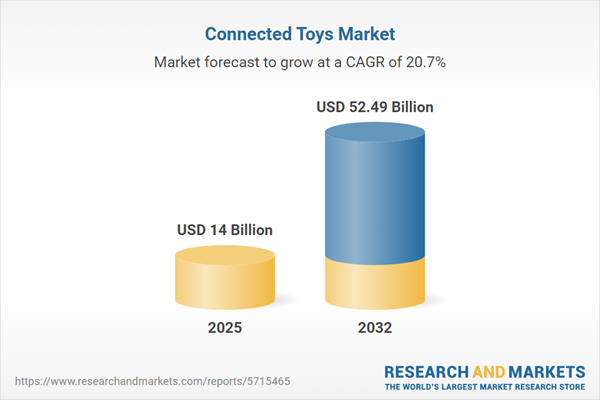Speak directly to the analyst to clarify any post sales queries you may have.
The connected toys market is transforming rapidly as interactive technologies reshape digital engagement and business strategies on a global scale. Senior decision-makers need clear insights into emerging trends, technology adoption, and operational challenges that define the competitive landscape.
Market Snapshot: Growth Trajectory of the Connected Toys Market
The connected toys market is demonstrating robust growth, rising from USD 11.63 billion in 2024 to USD 14.00 billion in 2025 and projected to reach USD 52.49 billion by 2032. This expansion is primarily driven by the integration of advanced digital features into traditional toys, fundamentally changing interactive entertainment and learning experiences. Companies are leveraging connected toys to access new channels and more effectively meet the needs of educational, professional, and personal users. As market dynamics shift, businesses have unprecedented opportunities to support skill development and engagement among increasingly diverse user segments, positioning themselves for long-term success in a dynamic environment.
Scope & Segmentation: Insights for Strategic Leadership
- Product Types: Doll and action figures, educational products, electronic pets, games, puzzles, and robotic toys accommodate multiple user preferences, supporting both consumer and institutional procurement strategies.
- Educational Toys: Coding-focused tools, language learning products, and STEM kits help organizations advance structured and informal learning goals in a variety of settings.
- Robotic Toys: Companion devices and learning robots deliver adaptive interactions, adding value for both home and institutional environments.
- Distribution Channels: Direct sales, hypermarkets, supermarkets, e-commerce, manufacturer websites, and specialty stores provide companies with options to optimize omnichannel strategies and agile supply chains.
- Connectivity Technologies: Bluetooth, cellular, NFC, and Wi-Fi enable seamless integration, supporting high user engagement across devices and platforms while enabling new experiences in various industries.
- Geographic Coverage: Assessment includes the Americas, Europe, Middle East & Africa, and Asia-Pacific. The market highlights regional trends in China, India, and the United States, revealing unique growth drivers and challenges in each geography.
- Key Companies Profiled: Leading organizations such as Mattel, Hasbro, LEGO, VTech, Spin Master, Bandai Namco, WowWee, UBTECH Robotics, Sphero, and MGA Entertainment set industry benchmarks and influence innovation strategies globally.
Key Takeaways: Strategic Insights for the Connected Toys Sector
- Artificial intelligence enables connected toys to deliver richer, more personalized learning pathways, appealing to diverse learner and consumer needs.
- Prioritizing data privacy and robust parental controls is essential for regulatory compliance and building long-term brand trust with institutional and individual clients.
- The evolution of e-commerce empowers brands to better understand user behavior, supporting tailored product design and repeat purchases.
- Sustainability initiatives, including material innovation and enhanced product repairability, are gaining traction among educational buyers and public-sector institutions.
- Advanced analytics now inform performance evaluation and measurable educational outcomes, delivering value for both enterprise and academic stakeholders.
- Regional approaches diverge: Western markets emphasize privacy and ecological design, while Asia-Pacific accelerates adoption of robotics and immersive solutions.
Assessing Tariff Impact: Navigating Value Chain and Supply Stability
Recent United States tariff changes on toys and electronics are prompting organizations to reevaluate global supply chains. Many businesses are pursuing tariff exemptions and considering site diversification, reshoring, or nearshoring to reduce risk and enhance supply dependability. Strategic measures include renegotiating supplier contracts, establishing regional distribution hubs, and refining inventory management—all supported by investment in logistics systems. These actions strengthen a company’s resilience to regulatory shifts and enable stable delivery to clients worldwide.
Methodology & Data Sources
This report uses a mixed-method framework, synthesizing industry data, regulatory reviews, and qualitative interviews with product managers, supply-chain professionals, and select end users. Validation is supported through benchmarking and triangulation processes, ensuring accuracy for executive-level strategy and planning in the connected toys market.
Why This Report Matters
- Enables senior leadership to make informed, data-driven investment decisions that are responsive to shifting market and consumer landscapes.
- Prepares organizations to proactively address evolving regulatory requirements, supply chain changes, and market competition, creating resilient, future-ready strategies.
- Provides critical perspective on key technological advances and regulatory changes, supporting clear, actionable long-term planning.
Conclusion
In the connected toys sector, adaptability and proactive investment remain central to sustained success. Strategic decisions grounded in clear research enable organizations to lead confidently in a continuously evolving market.
Additional Product Information:
- Purchase of this report includes 1 year online access with quarterly updates.
- This report can be updated on request. Please contact our Customer Experience team using the Ask a Question widget on our website.
Table of Contents
3. Executive Summary
4. Market Overview
7. Cumulative Impact of Artificial Intelligence 2025
List of Figures
Samples

LOADING...
Companies Mentioned
The key companies profiled in this Connected Toys market report include:- Mattel, Inc.
- Hasbro, Inc.
- LEGO A/S
- VTech Holdings Limited
- Spin Master Corp.
- Bandai Namco Holdings Inc.
- WowWee Group Limited
- UBTECH Robotics Corp.
- Sphero, Inc.
- MGA Entertainment, Inc.
Table Information
| Report Attribute | Details |
|---|---|
| No. of Pages | 186 |
| Published | October 2025 |
| Forecast Period | 2025 - 2032 |
| Estimated Market Value ( USD | $ 14 Billion |
| Forecasted Market Value ( USD | $ 52.49 Billion |
| Compound Annual Growth Rate | 20.7% |
| Regions Covered | Global |
| No. of Companies Mentioned | 11 |









